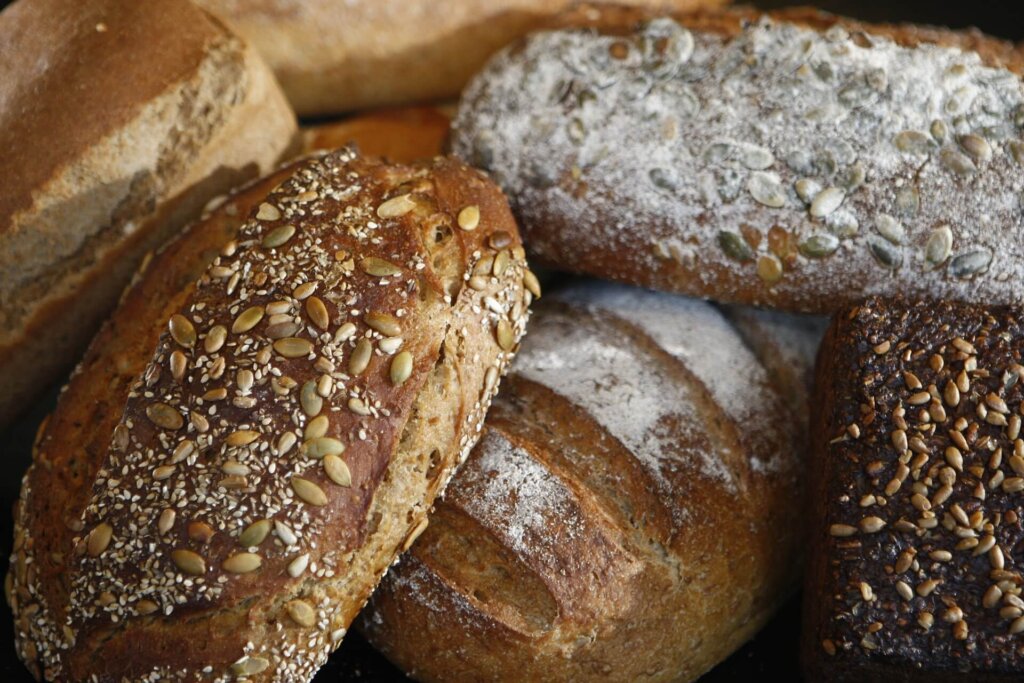Forse non lo sapete, ma il pane integrale è alla base di un lungo e articolato dibattito sulle sue differenze – in punto di gusto, ma anche nutrizionali e, di conseguenza, di effetti sulla nostra salute – rispetto al pane bianco. Eh già, perché se i benefici del pane integrale ci sembrano evidenti già dal suo aspetto visibilmente più “sano” in realtà non per tutte le tipologie e non per chiunque lo mangi è così.
Inoltre, quando ci si approccia al pane integrale, sarebbe sempre meglio informarsi. Come spesso accade per i cibi dietetici o salutari, si tende a consumarne quantità maggiori nell’erronea convinzione che non siano nocivi. Con il rischio poi di scoprire che anche il pane integrale fa ingrassare, o che quello confezionato non è così sano come pensiamo.
Ma insomma: quali sono i suoi benefici, e quali le differenze con il pane bianco? È proprio quello di cui vogliamo parlarvi in questo articolo.
Pane integrale proprietà e caratteristiche: conosciamo meglio il pane integrale
Il pane con farina integrale è, nella sua versione tradizionale, realizzato con una farina costituita da crusca, germe e amido. Il pane bianco vede una maggior composizione di amido, che costituisce la quasi totalità della farina, mentre nel pane integrale la crusca e il germe di grano vengono conservate, e questo è sicuramente importante perché si tratta delle parti del seme che contengono la maggior parte delle sostanze nutritive.
Si tratta quindi anzitutto non di un pane con un minor apporto calorico, ma di un pane con un maggior apporto di nutrienti a parità di calorie. Ma, c’è un ma: infatti, non tutto il pane che sembra integrale lo è davvero. Data la sua popolarità, si è cercato di accontentare le richieste del mercato introducendo pane con una colorazione scura addizionato di crusca. Insomma, se vedete del pane nero, non è detto che sia davvero integrale. Soprattutto, non è detto che si tratti davvero di un prodotto più sano o di un prodotto naturale.
Pane integrale valori nutrizionali
I benefici sono davvero numerosi, basta guardare i valori nutrizionali per rendersene subito conto. Ovviamente questi variano da ricetta a ricetta, ma in linea generale possiamo dire che un pane con farina integrale può apportare fibre, ferro, calcio, vitamina K, sodio, zinco, selenio, folati, colina e potassi, oltre a magnesio e fosforo.
Insomma, con circa 70 grammi al giorno si assumono importanti nutrienti – ancor di più se si sceglie il pane integrale con farina multicereali – ma anche un adeguato apporto di fibre che agevolano la pulizia del tratto intestinale. Inoltre, l’assunzione di pane ricco di fibre fa sì che l’indice glicemico risulti meno alterato (e meno velocemente), apportando benefici anche alle persone affette da problematiche come il diabete e l’insulino resistenza. Ma non solo, perché inserendolo in una dieta equilibrata, si riesce a fornire un’adeguata protezione alla salute, con incidenza anche sulla pressione (e quindi sulle malattie cardiache) e, addirittura, sulle patologie connesse al benessere delle gengive.
Pane integrale: calorie e il suo rapporto con la dieta
Se vi state chiedendo se il pane integrale fa ingrassare, sappiate che la risposta è no. In linea generale, non è più calorico del pane bianco e non fa ingrassare più di quest’ultimo. Al contrario, si tratta in alcuni casi di un valido alleato per perdere peso o semplicemente per monitorarlo. Ma, c’è un ma. Molto dipende, infatti, da quello che compriamo: un pane integrale confezionato può essere semplicemente un pane bianco addizionato con la crusca, e quindi come tale andrà valutato.

Questo perché alla domanda “quante calorie ha il pane integrale?” dobbiamo dare una risposta un po’ più complessa rispetto al semplice: “meno calorie del pane bianco” che molti sperano di sentire. Anzitutto, infatti, ha più o meno le stesse calorie di quello bianco, circa 300 per 100 grammi. Bisogna tuttavia considerare due fattori:
- I valori nutrizionali: a parità di apporto calorico, contiene molti più nutrienti del pane bianco e, soprattutto, introduce nell’organismo delle fibre utili sia per il benessere dell’intestino che per non dare picchi glicemici. Con la conseguenza che ha di fatto un’incidenza diretta sul controllo del peso: da un lato ci si sgonfia grazie a una corretta attività intestinale e, dall’altro, non si subiscono quei picchi glicemici che sono responsabili degli attacchi di fame;
- L’acqua: ha un contenuto in acqua assai più elevato rispetto al comune pane bianco. La conseguenza? Una fetta da 70 grammi contiene meno grano e, quindi, meno calorie. Quindi se 100 grammi di pane integrale hanno lo stesso apporto calorico di pane bianco, una sola fetta non avrà le stesse calorie di una fetta di pane bianco, perché l’acqua, presente in proporzione più elevata, non ha calorie.
Facciamo attenzione: qualche consiglio finale
Abbiamo analizzato il pane integrale e le sue differenze rispetto al pane bianco. Poi abbiamo parlato dei suoi benefici, e scoperto che fa bene alla linea, oltre che alla salute. Infine, abbiamo scoperto che sotto la dicitura “pane integrale” può nascondersi un pane bianco colorato con la crusca. Cosa c’è da sapere ancora? Alcuni piccoli consigli su come ottenere il massimo dei benefici da questo alimento, ovvio!
Anzitutto, abbiamo detto che ce ne sono diversi tipi, ma non vi abbiamo ancora detto come trovare quello “vero”. Purtroppo, ad oggi non ci sono regole che vietano di classificare il pane come integrale anche se è solo addizionato. Per cui il consiglio è di rivolgervi o al panettiere di fiducia oppure a un negozio di prodotti biologici.
Il secondo consiglio riguarda invece il controllo del peso. Molti tendono a esagerare con le quantità quando si trovano davanti prodotti sani o dietetici, nell’erronea convinzione che “non facciano male”. Attenzione quindi a massimizzare i benefici inserendolo nella dieta esattamente come usereste quello bianco. Con parsimonia, senza esagerare, e soprattutto senza aggiungere condimenti e intingoli più grassi rispetto alle vostre abitudini.
E adesso? Beh, buon appetito!




